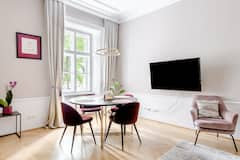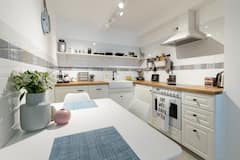The Belvedere Complex, located several minutes ride from the centre of Vienna, is among most iconic Viennese landmarks and must-see destination for any traveller to the Austrian capital. The Baroque complex consists of two extraordinary palaces, the Upper (Oberes) and the Lower (Unteres) Belvedere, and extensive and splendid gardens. Both palaces are settings for wealthy art collections comprising various paintings and sculptures, accompanied by exclusive architectural details, both from the outside and the inside.
The Upper Belvedere, as seen from the south

The Belvedere complex was created in the 18th century, south of the city walls; the grounds were purchased by Eugene de Savoy, the “Scourge of the Turks”, a distinguished military leader who defended Vienna during the 1683 siege and permanently ousted the Turks from this part of Europe. He was also a great fan of art, commissioning famous architects and artists to create and embellish his summer residence. As a reminiscence of his military life, the roofs of the Upper Belvedere symbolize the Turkish army camp tents.
Although constructed after the Lower Belvedere, the name of the complex is related to the Upper Belvedere, meaning “the beautiful view”. Truly, as seen from the base of the palace, and especially from its upper floors, the stunning views stretch along the magnificent Baroque garden between the palaces, enveloping the city behind.
Masterpieces of the Upper Belvedere

The Upper Belvedere was erected in a rush, due to Eugene’s impatience to see it completed, despite the main architect’s unwillingness to assume such an approach. Look out for the Sala Terrena as you enter the palace. This is where four pillars of Atlases support the vault and it is one of the ingenious remedies used to fix the rotten ceiling that threatened to collapse a few decades after the completion of the palace.
Works of art of the Upper Belvedere

As you approach the first floor where the extensive collection of the Austrian Gallery of 19th and 20th Century Art is showcased, you shall notice beautiful sculptures, stylish lanterns, chandeliers and stucco details along the staircase, walls and ceilings.
The central salon named Marmorsaal (meaning “the Marble Room”), which you can enter from the monumental staircase, occupies two stories and is the most magnificent room in the Upper Belvedere (the homonymous room can be found also in the Lower Belvedere). Richly decorated with paintings, stucco works, and diverse architectural details such as Corinthian columns, medallions and such, it pays homage to Eugene de Savoy and his achievements. In this room, the Austrian State Treaty, which inaugurated Austria as an independent state, was signed in 1955.
You might be interested in these Airbnbs!
The Marmorsaal of the Upper Belvedere

Both upper floors house significant art collections, prevalently belonging to Secession and Biedermeier artists. Rudolf and Jacob von Alt, Friedrich von Amerling and Moritz Michael Daffinger are a few of the most distinguished artists of the Austrian Secession. The largest section, however, is dedicated to the works of Gustav Klimt, the founder of the Viennese Secession, which houses his largest collection of paintings in the world.
Some of his most famous paintings, such as The Kiss, Judith and Portrait of Sonja Knips, are showcased here. As for the sculptures, the most interesting ones are the caricature heads, completed by Franz Xavier Messerschmidt.
The Lower Belvedere exhibits significant baroque examples of the 17th and 18th works in the Austrian Baroque Museum. Besides the garden on the southern side of the property, featuring a grand basin, the Baroque garden linking both palaces is exceptional due to exquisite geometric patterns. Various fountains, sculptures depicting mythological creatures, well-manicured lawns, trees and other greenery are dotted throughout the garden.
Vienna Tour Guide

Ildiko
Make the most of your time at Belvedere
To tour both palaces of the Belvedere complex you’ll need to purchase separate tickets or passes combining other attractions (e.g. Winter Palace and 21er Haus). However, if you have limited time (which is mostly the case), the Upper Belvedere would be the best option for a quick visit (2 or 3 hours would be sufficient), thanks to its extensive art collection and outstanding views.
The full price for the Upper Belvedere is 14 EUR (16 USD), while the ticket for the Lower Belvedere costs 11 EUR (12.50 USD). Don’t be discouraged if the queue is long, as it goes really fast. To make the most of your visit, perhaps it would be wise to arrive early, so you can rent an audio guide, which tends to be “sold-out” quickly. Operating hours of the complex are from 10:00 am to 06:00 pm daily. Note that taking photos in the museum premises is not allowed.
History
Get Trip101 in your inbox
Unsubscribe in one click. See our Privacy Policy for more information on how we use your data




















Create an account to